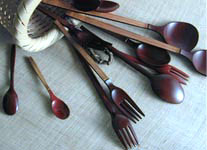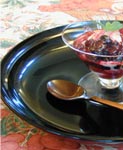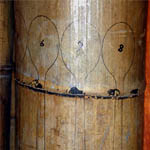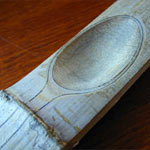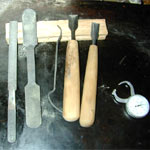 |

|

Fushimi
Maki’s Biography
|
|
1957
|
|
Born
in Yokohama |
|
1978
|
|
Enters
Kamakura-Bori Training School. (Trains in carving and lacquering) |
|
1980
|
|
Graduates
Kamakura-Bori Training School. Enters Kamakura-bori Hakujitsudo,
begins training in carving After two years, commences study
in lacquer coating. |
|
1984
|
|
Enter
Sato Senro’s Lacquer Ware Studio as an apprentice (Nagano
Prefecture, Kiso County). Starts his training by learning
how to make daily household lacquer craft wares.
|
|
1987
|
|
Establishes
his own workshop. |
|
1991
|
|
Awarded
Japan Folk Craft Museum, Encouraging Award Holds solo exhibitions
in Saitama Prefecture, Kumagaya-shi, and in Tokyo metropolitan
area. |
|
1994
|
|
Moves
his studio to Kanagawa Prefecture, Hayama-machi |
|
2000
|
|
Various
solo exhibitions in Tokyo metropolitan area Fushimi |
|
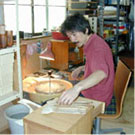
(Fushimi working in his studio) |
|
|
Maki’s Spoons
and Forks

As handmadejapan.com
wishes to cover more in depth and share the beauty found in the
world surrounding bamboo craft, this feature will present his
bamboo spoons and forks. We will introduce total 9 types. Spoons
and forks used for pasta and curry, soup, dessert, salad, etc.
They all vary in size. Each piece is exquisite with the lacquer
blending harmoniously with the bamboo core. Among the “bread-and-butter”
works, his bamboo series are actually one of his favorite personal
hobby-like creations. These pieces created with his distinctive
unpretentious air are so attractive that one can not resist from
reaching out to hold them in one’s hand and try to touch with
his lips.
"Beauties"
created by the artist’s magical hands
You can definitely see his professional skill in the carvings.
By accumulating knowledge through experience working with bamboo,
he is able to understand more in depth, the quality of the bamboo.
He aims to create each piece bringing out the best of the bamboo.
He takes no shortcut, and his dedication can be seen in the full-fledged
process of making these spoon and forks with seven layers of coatings.
Now let’s take a look at the process.
|
|
|
 |
First,
a very thick, moso-chiku bamboo is obtained from the bamboo yard.
The bamboo is left to dry naturally for a period of time. Next,
on the bamboo’s curved surface, the shape of a spoon is traced
from a pattern paper. Very carefully, small slits are made into
the bamboo with a saw. The firmness of bamboo sheath and the flesh
is totally different. The outer layer is extremely hard, and the
blade quickly becomes dull. On the other hand, the inside can
be easily carved with a carving knife, or chisel.
After the bamboo is split into individual pieces, the process
of chiseling the curve (concave) of the spoon follows. After much
trial and error, the method he has contrived is to make several
small diagonal cuts along the surface. Carving the hard surface,
with just the strength of his fingers, will not only make the
sharp blades become dull quickly, his thumb will result in suffering
with arthritis. The small cuts on the surface, facilitates making
precise incisions with the blade. Gradually removing the outer
layer, the spoon curves are made to 1.5mm to 2.0mm thickness.
Following, is the trimming away of the excess bamboo with a small
handsaw. Finally, the bamboo begins to assume the shape of a spoon.
The rest is a long painstaking process of gradually carving out
with a chisel, working with his sensitive fingers as his guide.
Next, the protruding (convex) surface of the spoon curve is meticulously
sanded. It is not possible to sand the concave surface of the
curve. To avoid any bumps visible with the lacquer coating, the
irregularities of the surface must be carefully smoothed over
with the chisel.
Rather than leaving rough rugged cuts or bold primitive finishes,
he chooses to carve until he is satisfied with the exact precision
and elegance. Because bamboo is rather a simple and unsophisticated
material, he places much energy to finish each piece to perfection.
His attention to the details is incredible. The artists concern
definitely goes beyond many. He carefully calculates the size
and the smoothness of the spoon, as it touches against one’s sensitive
lips. The distinctive smooth touch of the lacquer, and the subtle
curve of the spoon, should flatter the food carried into one’s
mouth. He finds many utensils today are focused on modern shapes
and form. Unfortunately, they are often not very comfortable when
eating, moreover, it makes the person look extremely unattractive
when eating. Yes, his concern goes to that extent.
A lacquer-coated ladle and spoon have been made since early times.
However, this is the first time I have ever seen a lacquered fork.
They are not at all delicate as the tiny forks for Japanese confectioneries.
On the contrary, they are very sturdy forks that you can actually
pick fresh cucumbers in your salads, or twirl pasta from your
plate. The idea that you can use this fork like any other metal
forks is so exciting.
The artist works into the late hours of the night, using simple
tools, carving away and polishing the agile forks, with the distance
sound of the waves from the Shonan beach. The contrast of the
smartness of his forks and the long hours and tedious labor just
seems incongruous to me. There must be a reward for those who
endure repeated manual labor. I can only imagine how immense the
sense of fulfillment he must feel.
to
the shopping page
|
Service-plate,
dinner-plate, soup plate, salad bowl
Let us also introduce
beautiful plates and bowls that matches the bamboo spoons and
forks. They too, are “natural beauties”. There are four types:
service-plate, dinner-plate, soup plate, and salad bowl. Placing
a ceramic plate beneath the urushi plates will create an exquisite
presentation, adding even more panache to your table.
|
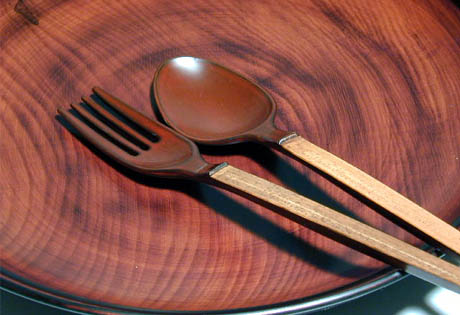 |
|
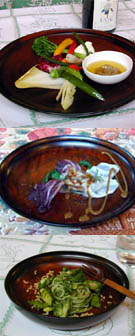
|
Enticing
Italian dishes with the vessel
Fushimi’s lacquer
ware is a handy utensil that can be used for culinary delights
from any nationality. Here we show you delicious dishes prepared
by Chef Kojima Masaaki, from the Italian restaurant Aqua Pazza
in Minami- Aoyama, Tokyo.
On the service plate
the chef has prepared "Bagna Cauda with Season Vegetables".
You can see the fine wooden grains through the transparent lacquer.
On the dinner plate
is a delicious "Smoked Duck Hamburger Steak with Balsamico
Sauce".Of
course, any homemade hamburger served on this plate will look
sharp and stylish.
In the soup bowl
is the tasty "Green Perilla (Japanese Basil) Cold Fedelini
Pasta Seasoned With Green Vegetables and Botargo".
|
|

|
|
|
 |
 |



